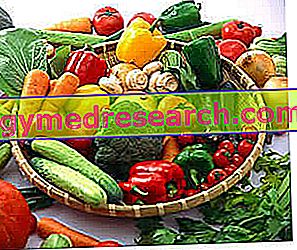Generality
Regarding the etymology of the noun, vegetables means: " green color of vegetation ". On the other hand, in spoken language, vegetables are more like a set of foods of plant origin, whose color - as opposed to what could be deduced - is NOT ONLY green.

Vegetable is a synonym of vegetable, even if the two substantives can be diversified according to the production level / technique: "vegetables", those cultivated in the vegetable garden and "vegetables" those obtained on a large scale; based on this criterion, vegetables and vegetables also differ in the length / duration of the commercial chain. For more details see the article: Vegetables: definition and properties.
From a nutritional point of view, the vegetable is between the VI and the VII group of foods, although many consider vegetables also certain legumes and potatoes (instead typical of the III and IV groups).
Types of Vegetables
The vegetables par excellence are those of green color, that is most of the leaves, flowers, bulbs and edible stems. However, certain fruits, roots and ("forcing" the definition) certain seeds and tubers can also be included in the same set. Let's look at them in more detail:
- Leafy vegetables: the most famous examples are: lettuce, radicchi (red, green, variegated), other chicory, chard (or chard), turnip leaves, rocket, parsley, basil (and other aromatic herbs), soncino, dandelion, spinach, cap, borage, leek, watercress, etc.
- Flower vegetable: it is little known but widely used; this means that most consumers buy it even if, in reality, they do not know that they are flowers! Pumpkin and courgette ones are evident, while others are more difficult to recognize: artichokes, broccoli, cauliflower, turnip broccoli (turnip greens) etc.
- Stem vegetables: it tends to be green or white, depending on the cultivation technique. Leaving them exposed to sunlight, the stems synthesize chlorophyll and become green; on the contrary, covering them (or leaving them buried) remain clear. Some examples are: celery, celeriac, fennel * 1, milk thistle etc.
- Bulb vegetable: it is often neglected but it is among the most consumed vegetable products in the kitchen. These are: onion, garlic, fennel * 1, shallots, etc.
- Root vegetables: it is quite easy to recognize; it has quite different colors and chemical characteristics. Some examples are: carrots, radishes, American potatoes (tuberous roots) * 2, turnips, parsnips, horseradish, ginger, daikon etc.
- Vegetable with tuber: differentiated from the previous category mainly due to its nutritional characteristics, according to which it should not be considered a real vegetable! It mainly consists of: potatoes, Jerusalem artichokes, American potatoes (tuberous root) * 2.
- Seed and pod vegetables: the seed vegetable is mainly composed of legumes; similar to the tubers, these are foods whose relevance in the group of vegetables could be questionable. Some examples are: chickpeas, lentils, lupins, soybeans, beans, broad beans etc. As far as cereals are concerned, these are generally not included among the vegetables although, like legumes, their edible part is composed of seeds. The vegetable in pods is definitely more relevant; the two most indicative examples are the jackdaws and green beans.
- Fruit vegetables (drupes, berries, esperidi, pomi): unlike those mentioned so far, this type of vegetable is uniquely accepted, even though it may have many different colors. Some examples are: tomato, cucumber, courgette, pumpkin, aubergine, pepper etc.
Features and Nutritional Properties
Excluding the seeds and the tubers, the vegetables show quite overlapping nutritional characteristics. Some differences may affect the amount of sugar and total calories, but generally the various products do not deviate too much from 20-30kcal / 100g
Seeds and tubers excluded, vegetables are common to a series of rather defined chemical and nutritional characteristics; these are:
- Plenty of water: vegetables contain up to 95% of liquid. Consuming a good quantity of vegetables helps to avoid the onset of bodily dehydration and malfunctioning of the organism (hypovolemia, lithiasis, hypotension, poor physical-athletic fitness, etc.).
- Plenty of dietary fiber: vegetables, such as legumes, cereals and mushrooms, contain dietary fiber. This component positively affects the motility of the intestine, the purification of the colon and the trophism of the physiological bacterial flora; moreover, it modulates food absorption.
- Low energy intake: obviously, in such a large group, the energy supply of the extremes is quite different. In general (excluding seeds and tubers), vegetables play an almost marginal energy role in the diet, ie around 5% of total energy. Vegetable calories are made mainly from simple carbohydrates, or fructose; proteins (with a low biological value) and fats (mainly unsaturated, a good part of which are essential polyunsaturated) play a marginal role.
- Vitamin and salt richness: vegetables contain excellent doses of certain vitamins, especially A, C, E, K and folic acid. The same applies to the mineral salts, among which are mainly: potassium, magnesium, zinc and selenium. There is no shortage of iron and calcium but, on the other hand, they are present essentially in a little bio-available form.
- Presence of other nutritional molecules useful for maintaining the state of health: certain non-essential but extremely healthy molecules are also contained in vegetables, which help to keep cholesterol levels low and counteract oxidative stress. Among these we mention: phytosterols, lecithins and phenolic substances.
- Presence of anti-nutritional molecules: if on the one hand the vegetable is extremely nutritious, on the other it participates (to varying degrees based on the importance of the portions consumed) to reduce the absorption of certain nutrients. This is the case of phytic acid, oxalic acid and tannins.
We conclude by recalling that vegetables should be consumed both in a raw and cooked form. The first fully maintains its nutritional characteristics and is NOT subjected to oxidative, thermal or dispersive deductions; however, it contains greater amounts of both anti-nutritional molecules and less digestible fibers. The cooked form, on the other hand, makes it possible to consume larger portions, albeit less nutritious, but with the advantage of introducing many more fibers.
Watch our video recipes dedicated to vegetables and salads



